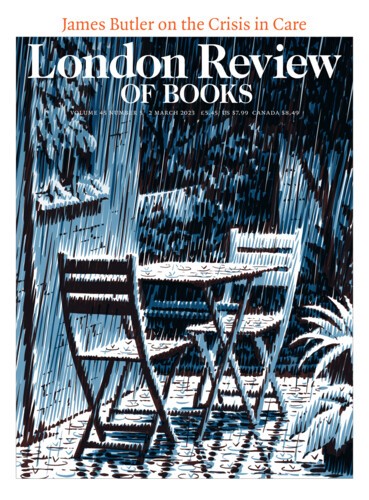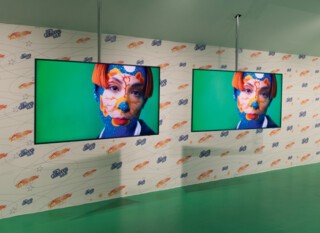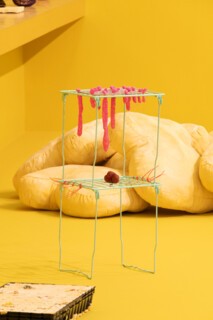In 2019, all four artists nominated for the Turner Prize – Helen Cammock, Lawrence Abu Hamdan, Oscar Murillo and Tai Shani – shared the award, not at the instigation of the judges but at the request of the artists themselves, who asked to be considered as a collective rather than individual entrants, ‘in the name of commonality, multiplicity and solidarity’. The prize was cancelled in 2020 because of the pandemic, then reinstated in 2021 with a shortlist composed entirely of artistic collectives. On accepting their nomination, the group Black Obsidian Sound System issued a statement outlining the reasons why they were minded not to. ‘The urgency,’ they wrote, ‘with which we have been asked to participate, perform and deliver demonstrates the extractive and exploitative practices in prize culture, and more widely across the industry.’ Artists of colour, they argued, like other under- represented groups, are ‘desirable’ but ‘dispensable’ to galleries such as Tate (the prize went to the Northern Irish collective Array).
It is hard to say what if any effect these recent interventions have had. The Turner Prize shortlist for 2022 consisted of four individual artists. The most visible change to the prize in the last decade has been the abolition of the upper age limit – it was previously restricted to artists under the age of fifty – and it seems significant that two of last year’s nominees, Veronica Ryan (the winner) and Ingrid Pollard, are women in their sixties, both associated with the British Black Arts Movement of the 1980s. The exhibitions for which they were nominated showed what it looks like to work rigorously for decades outside of the spotlight, and by implication asked why the British art establishment fails to recognise certain artists earlier in their careers. As Ryan went up to accept the award, she shouted: ‘Power! Visibility! We are visible people!’
The exhibition that accompanies the prize each year is a difficult prospect for curators. Four disparate artists must be presented in a way that doesn’t favour one particular practice or medium; the works need to be distinct, yet somehow in dialogue with each other. Rather than creating new work for the show, artists usually present a smaller version of the exhibition that prompted their nomination – a process which suits some more than others. It doesn’t help that the curators feel they must justify and explain the award (the press release says it is intended to ‘promote public debate’). Before encountering any of the artworks on display at Tate Liverpool (until 19 March), you have to pass through a room of explanatory wall texts and videos about each artist. It isn’t unusual for Turner shows to have a small introductory space, but here it feels non-negotiable, as does the order in which you navigate the exhibition. In previous iterations, the four different spaces could be accessed via a central atrium, which allowed you to move back and forth between them. At Tate Liverpool there is a clear beginning and end, at which point you cast your own (meaningless) vote for the winner by putting a plastic token in a box. The exhibition’s architecture discourages drifting, which is hard on artists whose work rewards a drifting engagement, as Heather Phillipson’s does.
Phillipson’s Rupture No. 6: Biting the Blowtorched Peach is a remix of her psychedelic, post-apocalyptic installation at Tate Britain’s Duveen Galleries in 2021, which took full advantage of the neoclassical surroundings. It must have been hard to translate the work, which included sound, colourful video projections and otherworldly sculptures, to the compact space it occupies at Tate Liverpool. The cluster of video screens showing animals’ eyes that was given a central position at Tate Britain is now a passageway, the screens flanking a short corridor that leads to a room in which glowing fibreglass rocks hang from the ceiling. Headphones dangle beside them, playing an audio collage composed of samples of weather forecasts, clusters of electronic tones and Phillipson’s own matter-of-fact voice. An announcer’s chirpy warning that it’s getting ‘much warmer’ is pitch-shifted and distorted; his authority (already questionable) is thoroughly warped. Phillipson, who is also a poet, keeps her words to a minimum but offers the memorable image of ‘the earth like a flambéed tomato’.
Her subject is the changing climate, more specifically its strangeness, as registered in the body through changes in light and temperature; and as information, mediated through recorded voices and pixelated images. Sometimes it buffets you; sometimes it’s just a hum. Rupture No. 6 bundles together physical and digital overflow, balancing a screen on a pile of crumpled foil blankets to show a looped and lo-fi video of swarming caterpillars. The centre of the installation is an agricultural silo, placed slightly on a slant as if deposited by a tornado. Inside, lit up by more glowing rocks, is a wind chime-like assemblage of empty gas canisters and chunks of metal suspended from beams and wooden wheels: the ‘wind’ comes from a large fan. On second glance, I noticed a safety instruction sticker, complete with diagrams of horrible accidents, still stuck to the inside of the silo door. This is immersion with limitations.
The building and dismantling of worlds also preoccupies Sin Wai Kin. Both Sin and Phillipson are influenced by speculative and science fiction: Phillipson seems drawn to science fiction’s capacity for imagining new ways of using things and organising materials, while Sin is preoccupied with its possibilities for different and mutable identities. They find connections between the parables of the Taoist philosopher Chuang Tzu and the fantasy worlds of pop music and drag performance. In their installation It’s Always You, Sin becomes all four members of a boy band along the lines of BTS or the Cantopop group Mirror, complete with costumes, make-up and archetypal nicknames (‘The Universe’, ‘The Storyteller’). They have filled a room with ephemera including ‘It’s Always You’ wallpaper, signed posters and life-sized cut-outs of the group as well as a video of one of their songs – except it isn’t really a song, but a single verse sung by each member of the band in turn, a dreamy incantation accompanied by vague, delicate synth chords. Lyrics run across the screen: ‘I see myself in you’; ‘You’re the one in me.’ Sin is right that pop can be a vehicle for big ideas about existence: I thought of the Stylistics’ song ‘You Are Everything’, which gestures to something far greater than just missing a lover – a cosmic yearning, conveyed not only by the lyrics but also by the circling melody of the chorus, the squelchy guitar and Russell Thompkins Jr’s falsetto. It’s a lot to expect Sin, who has crafted an intricate visual pop universe, to craft intricate pop music, too. But the problem with using pop as a metaphor for philosophical ideas is that pop musicians have been doing it for decades.
Members of boy bands often attempt solo careers, and The Universe – blue-haired and swaggering, with a lotus flower painted on his face – appears again in A Dream of Wholeness in Parts, a 23-minute film that was included in the Hayward British Art Show last year. The Universe’s counterpart is The Construct, a striking figure in precarious platform shoes, ornate jewellery and a cream silk blazer that opens to reveal large prosthetic breasts. Her make-up is that of a daan, a generic feminine role in Cantonese opera. Sometimes appearing as two identical figures, she plays chess with her double in a bland luxurious apartment. The Universe seems easier in his skin. He talks to a tree (it talks back) and slurps noodles in a café, reflecting on his dinner: ‘Once it was a pig, once it was a prawn, once it was matter and energy.’ Sin’s performances of gender animate the film, but it’s not ‘about’ gender, except as one of a number of ordering systems that, following Chuang-Tzu’s maxim ‘the name is the guest of the substance,’ are always being rethought.
Veronica Ryan’s room sits between Sin’s and Phillipson’s. The walls, shelves and a central low platform are painted a domestic shade of bright yellow. Ryan’s small sculptures demand a different kind of attention to the other works on show here, which bombard us with audio-visual information. This attention is not at all like being absorbed, but rather a charged, almost uncomfortable awareness of surface – something akin to what the poet Lisa Robertson calls ‘soft architecture’ and its preoccupation with ‘shreds of fibre, pigment flakes, the bleaching of light’. Ryan employs discarded materials of all kinds, often items that hold or bind other things: twine, cable ties, netting, jiffy bags, seed pods, cardboard trays from packaged fruit. She makes containers, too: long, pendulous pouches crocheted from bright thread and containing stones and seeds.
Other smaller bags and nets feel less protective, more ominous, dangling from a spindly shelving unit like egg sacs. There is a tendency to linger on the physical vulnerability and discomfort evoked by these pieces, part of a series called Infection which includes plaster casts of yellowing orthopaedic pillows, but it would be a mistake to project Ryan’s slow path to professional recognition onto the work itself. This isn’t outsider art. Having worked steadily for four decades, she would have been justified in presenting a retrospective, but most of the sculptures were created in 2020 and 2021, during the residency at Spike Island in Bristol that resulted in her exhibition Along a Spectrum. She was awarded the Turner Prize for this work but also for her public sculptures of Caribbean fruit, commissioned in honour of the Windrush generation and installed in East London. Fruit and seeds have figured in her work for many years, including a recent series called Multiple Conversations. These small, enigmatic meetings of organic and synthetic substances – fruit skins, polymer clay, plastic – are not so different from the big soursop, breadfruit and custard apple in marble and bronze opposite the Marks & Spencer on Mare Street, Hackney. That they do not make their associations obvious to all is part of the point.
Ingrid Pollard’s Carbon Slowly Turning, put together for Milton Keynes’s MK Gallery, was a much overdue survey of her work since the 1980s, including the Pastoral Interlude series: annotated photographs of her friends – often other young Black artists – in the British countryside. When I saw the show in Margate last year, there was so much to look at that it was hard to appreciate how deftly Pollard arranges her compositions, placing images, objects and bodies in uneasy relation. This sharp edit, pared down to two rooms, makes clearer her demands on the viewer.
Pollard’s early training as a photographer took place in London’s community darkrooms and workshops – spaces created in defiance of art schools and professional studios. In the selection made for Tate Liverpool she returns to this period, both directly – as in No Cover Up, a recent project with the Lesbian Archive of Glasgow Women’s Library, for which she printed on fabric images from 1980s protests – and obliquely, with work that incorporates objects and sounds. Seventeen of Sixty-Eight is an installation developed out of many years of research into places where pub signs and place names reference Britain’s colonial and racist history. At first glance, it’s just a collection of photographs and artefacts: it could be a room in a municipal museum. But something isn’t right. There are no labels. Some images are hung uncomfortably high. The photographs show places on the verge of disappearing: there’s a huge abandoned pub with boarded-up windows and a ruined building overgrown with ivy and red valerian. Pollard doesn’t reveal where these places are, or where she found the statue of a Black chef holding a menu board. Rather, she invites us to pay attention to traces: the way names stick to locations, even when a sign comes down or a building is demolished. On one wall, ‘Black Boy’ pub signs have been turned into embossed prints. The subjects’ caricatured faces are rendered in raised white lines on white card, forcing the viewer close to the image.
The choreography of fascination and revulsion that these embossed images provoke is echoed in Bow Down and Very Low – 123, a series of three noisy kinetic sculptures made with the artist Oliver Smart. Pollard has called them ‘body-ish’, and this seems right: they are anthropomorphic, but effortfully so, as though made by someone who understands bodies only at their worst. One piece has a baseball bat that bounces and swings; in another, a baton is attached to two saws that bend and screech as they rock back and forth. The central sculpture, made from twisted ropes and old pram wheels, executes a graceless bow. A row of freeze-framed images of a young Black girl curtseying is displayed behind the contraptions – stills from a public information film. No effort has been made to soften the sound of the machines, which is at its most horrible when they slow down, exhausted.
In the catalogue for Carbon Slowly Turning, Paul Gilroy writes that Pollard’s collection of place names ‘raises questions about the tenacity with which they are defended, and why the well-documented history from which they sprung was so forcefully denied’. I thought of this in January when Haringey Council officially changed the name of Black Boy Lane in Tottenham to La Rose Lane. The new name commemorates John La Rose, who founded the Caribbean publishing house New Beacon Books in 1966. Newspapers made sure to find local residents who were angry about the change: such narratives are well oiled; they spin smoothly into motion. Pollard and her ‘unruly generation’, as Gilroy puts it, continue un-smoothing.
Send Letters To:
The Editor
London Review of Books,
28 Little Russell Street
London, WC1A 2HN
letters@lrb.co.uk
Please include name, address, and a telephone number.



